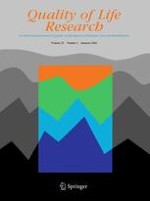13-08-2015
Development of an item bank for computerized adaptive test (CAT) measurement of pain
Gepubliceerd in: Quality of Life Research | Uitgave 1/2016
Log in om toegang te krijgenAbstract
Purpose
Patient-reported outcomes should ideally be adapted to the individual patient while maintaining comparability of scores across patients. This is achievable using computerized adaptive testing (CAT). The aim here was to develop an item bank for CAT measurement of the pain domain as measured by the EORTC QLQ-C30 questionnaire.
Methods
The development process consisted of four steps: (1) literature search, (2) formulation of new items and expert evaluations, (3) pretesting and (4) field-testing and psychometric analyses for the final selection of items.
Results
In step 1, we identified 337 pain items from the literature. Twenty-nine new items fitting the QLQ-C30 item style were formulated in step 2 that were reduced to 26 items by expert evaluations. Based on interviews with 31 patients from Denmark, France and the UK, the list was further reduced to 21 items in step 3. In phase 4, responses were obtained from 1103 cancer patients from five countries. Psychometric evaluations showed that 16 items could be retained in a unidimensional item bank. Evaluations indicated that use of the CAT measure may reduce sample size requirements with 15–25 % compared to using the QLQ-C30 pain scale.
Conclusions
We have established an item bank of 16 items suitable for CAT measurement of pain. While being backward compatible with the QLQ-C30, the new item bank will significantly improve measurement precision of pain. We recommend initiating CAT measurement by screening for pain using the two original QLQ-C30 pain items. The EORTC pain CAT is currently available for “experimental” purposes.
